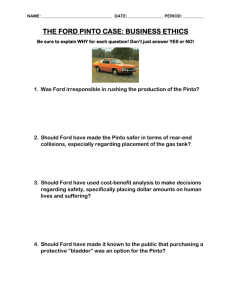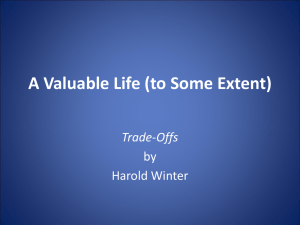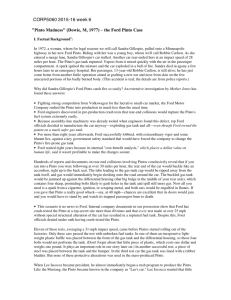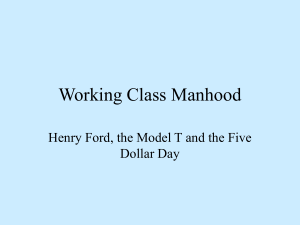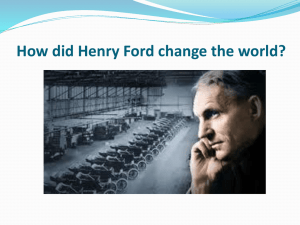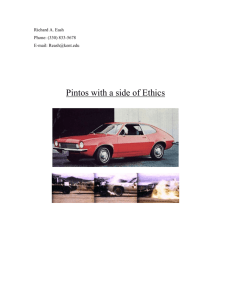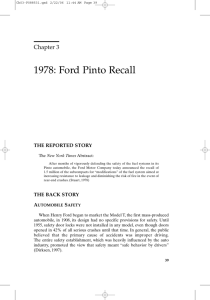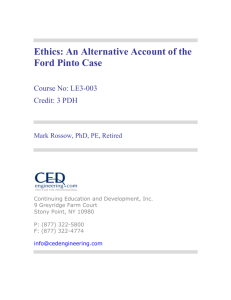PINTO case study
advertisement
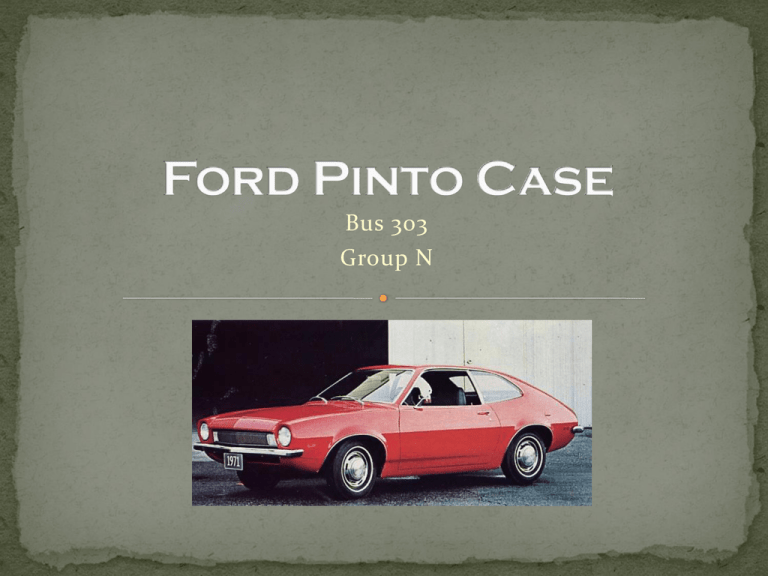
Bus 303 Group N "You don't want to talk about the Pinto," said a Ford official. "Leave that one in the cemetery." When people talk about how bad American small cars created an opportunity for the Japanese to come in and clean house in the 1970s and '80s, they are referring to vehicles like this. The Ford Pinto – a small car to compete with foreign car company competitors Pinto – weighed 2000 lbs and cost $2000 Rushed project led by Lee Iacocca Planning took 25 months compared to the industry norm 43 months “We are a global, diverse family with a proud heritage, passionately committed to providing outstanding products and services that improve people’s lives.” Testing found several safety defects @ 25mph+ the gas tank would rupture in an accident @ 30mph+ rear endings would cause the gas tank to leak and the rear of the car to be folded up into the back seats @ 40mph+ the car doors would jam Behind Rear-Axle Tank Pros: More Luggage space Industry standard – felt it was safer Con: Not as safe in rear-end collisions Over-the-axle-tank Pro: Performed well in rear-end collisions Cons: Long “round-about” filler pipe Closer to passengers in back seat Higher center of gravity Reduced trunk space Of 40 tests, 37 resulted in ruptured gas tanks. The three that succeeded had: --a plastic baffle between the tank and the differential bolts -- a piece of steel between tank and bumper -- a rubber “bladder” inside the gas tank More crash tests showed that a one-pound, one-dollar piece of plastic stopped the puncture of the gas tank. The idea was thrown out as extra cost and extra weight. Besides, tooling was already well under way. If you ran into that Pinto you were following at over 30 miles per hour, the rear end of the car would buckle like an accordion, right up to the back seat. The tube leading to the gas-tank cap would be ripped away from the tank itself, and gas would immediately begin sloshing onto the road around the car. The buckled gas tank would be jammed up against the differential housing (that big bulge in the middle of your rear axle), which contains four sharp, protruding bolts likely to gash holes in the tank and spill still more gas. Now all you need is a spark from a cigarette, ignition, or scraping metal, and both cars would be engulfed in flames. If you gave that Pinto a really good whack—say, at 40 mph— chances are excellent that its doors would jam and you would have to stand by and watch its trapped passengers burn to death. Meant to require vehicles to withstand rear-end collision of 28 MPH Henry Ford II lobbied relentlessly against. Official auto industry line–cars don’t cause accidents; people and road conditions do. Tactic: last-minute documents; challenges to test results; lawsuits; private negotiating. The standard was delayed for 8 years. Component 1971 Costs Future Productivity Losses Direct Indirect Medical Costs Hospital Other Total $132,000 $41,300 $700 $ 425 $1,125 Property Damage Insurance Administration Legal and Court Employer Losses Victim's Pain and Suffering Funeral Assets (Lost Consumption) Miscellaneous Total Per Fatality $ 1,500 $ 4,700 $3,000 $ 1,000 $10,000 $900 $5,000 $200 $200,725 Cost Analysis Sales 11 million cars, 1.5 Benefit Analysis Savings: million light trucks 180 burn deaths, 180 Unit Cost serious burn injuries, $11 per car, $11 per 2100 burned vehicles truck Unit Cost Total Cost $200,000 per death, 12.5 million X $11 = $67,000 per injury, $700 $137.5 million per vehicle Total Benefit (180 X $200,000) + (180 X $67,000) + (2,100 X $700) = $49.5 million Costs Benefit Difference $137.5 Million - $49.5 Million $ 88.0 Million Richard Grimshaw 13-year old passenger in “Sandra Gillespie’s” 1971 Pinto Struck from behind; exploded; badly burned over 90% of his body; 20 years reconstructive surgery. Awarded $125 million in punitive damages $124 million profits made since Ford Pinto’s introduction Judge reduced to $3.5 million On January 15, 1980, the Ford Motor Company went on trial on charges of reckless homicide in the 1978 death of three Indiana teenagers who burned to death after their 1973 Fort Pinto was hit from behind by a van. Indiana state prosecutors alleged that Ford knew Pinto gasoline tanks were prone to catch fire during rear-end collisions but failed to warn the public or fix the problem out of concern for profits. The trial marked the first time that an American corporation was prosecuted on criminal charges—in this case, reckless homicide. Ford was acquitted in March; the case was too complex. The Pinto was discontinued in fall 1980. Ford was first urged to recall the Pinto in 1974, by the nonprofit Center for Auto Safety. Late in 1978, Ford recalled all 1971-1976 Pinto models (1.5 million cars) Modifications Longer fuel filler neck Plastic shields Protected from rear differential Protected from rear shock absorber Ford employees Lee Iacocca Henry Ford II Were they morally responsible to refuse to produce a car they knew would hurt the customer? Should they have put more effort into convincing Iacocca that this car was unsafe? Should they follow Iacocca’s commands regardless of their opinions since he is their superior in the company Is Iacocca responsible for the safety of his customers? Safety? What safety. Should he maximize profits for the company at any costs? If safety defects are found after production, does he have a moral obligation to inform all his customers? Should Iacocca have established a working environment where his employees did not feel that they would lose their jobs for disagreeing with him? Should Ford have trained his managers and presidents in safety? Does Ford have a responsibility to design a culture that encourages employees to bring up safety defects? Does Ford need to have a new policy that puts the has safety of their products more important than maximizing profits? Does Ford have a moral responsibility to do what is best for his shareholders Young and ambitious new president Foreign competitors entering N.A. market No small car to compete with VW Beetle and others The demand for results and profits are the most important aspect of business 1. Pay the $11 per vehicle 2. Explore different safety features 3. Restart the project from the planning process 4. Continue with production of the Pinto Pros Cons Repairs the safety defect High cost Saves Ford from potential Slight delay before launch lawsuits Protects Ford’s reputation Pros Cons A cheaper alternative could Pinto release would be be found Profit margin could be higher than first alternative Repairs the safety defect before launch delayed indefinitely Still decreases total profit Pros Cons Design can be more Significant delay of launch focused on safety Most costly alternative Improve Ford’s reputation Pros Cons Releases the Pinto to the Selling unsafe products to customers immediately customers – could lead to serious injuries and deaths The largest profit margin is obtained from each Pinto sale High chance of lawsuits against the company If/When injuries occur, loss of reputation Explore Other Safety Measures Repair the Pinto so that it is a cheap, safe car that will please the customers Act as a responsible company and not expose customers to unknown risks Implement a more cost effective option than adding the $11 safety addition Save lives by not releasing unsafe Pintos Ford workers were afraid to talk to Iacocca about the safety defects In Feb. 1978, Ford was sued for $128 million – more then 3 times the amount they had predicted May 1978 – Department of Transportation announces defects with the Ford Pinto – Ford recalls 1.5 million Pintos Mar. 1980 – Ford was charged with reckless homicide – acquitted of charges, however they stopped all Pinto production
